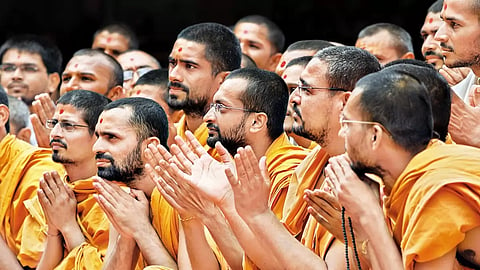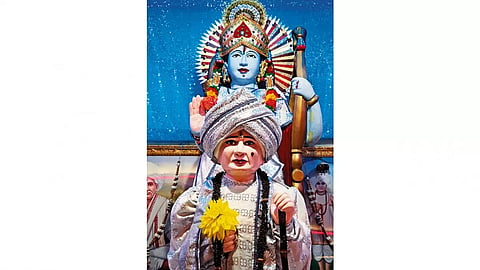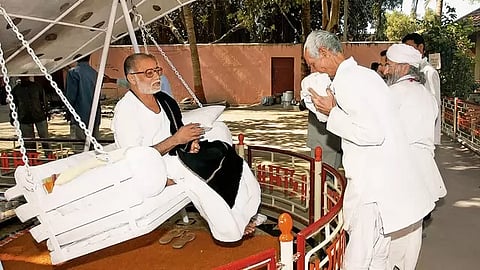The coming election to the Gujarat Vidhan Sabha is not going to? be different from the last six elections held since 1995, except that there is some excitement this time around due to the Aam Aadmi Party’s (AAP) fierce campaign aimed at turning the state’s traditional two-party system into a three-cornered contest. Barring the 1998 election, in which Shankarsinh Vaghela’s Rashtriya Janata Party garnered an 11 per cent vote share, all elections in Gujarat since 1995 have seen a contest between the Bharatiya Janata Party (BJP) and the Congress party.
Gujarat Polls: Is Arvind Kejriwal's AAP A Challenge To Modi's BJP? Not Really
The AAP would not be able to do much in Gujarat, where the BJP is culturally well entrenched and Modi has lost none of his personal charisma
Sensing the AAP’s capability to knock a piece out of its Patidar and Hindutva vote base, particularly in the urban areas, the BJP has been attacking the AAP more than the Congress party and urging voters to ignore the former. For once, the ruling party has stopped asking for a ‘Congress-mukt Bharat’. But should the BJP make a fuss over the AAP’s entry given that it itself rose as a hegemonic ruling party in Gujarat after remaining a third party from 1980 to 1995, alongside the Congress and the Janata Party and later the Janata Dal? Even in its earlier avatar, the Bharatiya Jana Sangh, it split the anti-Congress political space dominated first by the Swatantra Party in the 1960s and the Congress (Organisation) in the first half of the 1970s.
The BJP, the Congress and the AAP share a lot of commonalities in their ideological and programmatic orientation at the state level. The key differences among them exist only in terms of leadership, organisational network and strategies of electoral mobilisation. These factors make the BJP the most probable winner in the next election and the AAP no more than a good spoiler of the other two parties’ pitches. Moreover, the present government enjoys a high level of voter satisfaction. On the other hand, the AAP’s promise of freebies like 300 units of electricity every month and a regular stipend to all women are unlikely to rouse Gujarat’s voters much since there has been a historic, cross-party consensus in the state on following a liberal and centre-right economic policy that discourages excessive subsidisation and high, unproductive public expenditure.

The BJP’s uninterrupted sway over Gujarat’s voters for more than a quarter of a century is a result of its success in re-drawing the traditional faultlines of the state’s political society and amalgamating caste and subcaste identities under the larger frame of Hindutva politics, set off by LK Advani’s Ram Janmabhoomi Rath yatra from the Somnath shrine in 1990.
Besides, many years of focused grassroots activism by the Rashtriya Swayamsevak Sangh and its affiliate organisations and their control of dominant civil society spaces (milk cooperatives and dairies, professional associations, trade unions, farmers’ organisations etc.) strengthened the BJP to marginalise other parties.
Religiosity runs deep into the collective consciousness of the Gujaratis. Various ‘sampradayas’ (Swaminarayan and Vaishnavite sects, the Swadhyay Parivar, the Jalaram Bapa cult, the Gayatri Parivar etc.), kathakaars (Morari Bapu, Ramesh Oza ‘Bhai’ etc.) and spiritual gurus, who wield a more disproportionate political influence than expected from religious actors, have assisted the BJP’s growth. Strategic social engineering by the party caused the transfer of a large chunk of the Dalit, Kshatriya and Adivasi vote bank of the Congress to the BJP. But, of course, the transformation brought about by the fast spread of religious consciousness in the political domain in Gujarat has severely constrained the autonomous, assertive and non-violent civil society sphere - nurtured by the Gandhian movement, integral to the social life of Gujarat till the 1990s – the state has been famous for.

The Gujarati diaspora, estimated to be around one-third of the Indian diaspora worldwide, is an essential torchbearer of the Hindutva mobilisation. It is deeply involved not just with the state’s socio-economic development but also with its partisan politics. Many of them are now actively campaigning for the BJP through social media, while an estimated 25,000 non-resident Gujaratis are on the field to ensure that their relatives and residents of their native villages support the BJP.
Notwithstanding all of the above, the most significant factor that has consolidated the BJP-centric dominant party system in Gujarat is Narendra Modi’s magnetic leadership. He has single-handedly shaped Gujarat’s political trends during the last two decades. Modi assumed centre stage in Gujarat at the right time and timed his political strategies in the right way to rise to the top of national politics eventually.
Modi scripted the story of the re-imagining of Gujarati identity after the 2002 riots and the advancement of Gujarat’s economic development after the catastrophic earthquake of 2001. Most Gujaratis feel unqualified pride in having Modi, a fellow Gujarati, as the country’s Prime Minister. This pride is experienced not just by the BJP supporters but also by many Congress voters. Modi has created an impression among the common Gujaratis that only he can address their emotional vulnerabilities, fears and economic aspirations.
The campaign slogans he energetically chants at the current election rallies - “Hu Chhu Gujarat” (I am Gujarat) and “Aa Gujarat Me Banavyu Chhe” (I have built present-day Gujarat) - are in line with the ingenious public communication strategy he has followed over the decades to establish a direct connection with the masses. The new slogan is reminiscent of the ‘Main Bhi Chowkidar” (I am also a watchman) tagline popularised in the run-up to the 2019 Lok Sabha polls.

More than four million people have already uploaded their selfies on social media and the NaMo app displaying the slogan “Aa Gujarat Me Banavyu Chhe” which fuses his charisma, subliminal Gujarati pride and ideological agenda into a single line. However, the flip side of such a strong emotional bond between Modi and common Gujaratis is that it has made the latter possessive of him as a child would be about his mother. Knowing that Gujaratis would not get charged by the name of any state-level leader, Modi has to leave aside all important jobs of his office to address rallies at the maximum number of places and micro-manage his party’s campaign.
It is Modi’s uncanny knack for influencing the masses to identify with him and convert personal criticism into symbols of the victimhood of Gujaratis and Hindus that has driven the Congress and the AAP not to attack Modi directly in their campaigns. For instance, an ill-advised campaign by a section of the media and intelligentsia to caricature Gujaratis as minority-haters and Gujarat as a laboratory of some fascistic experiments boomeranged only to bolster Modi’s popularity.
An average Gujarati’s political attitudes are underpinned by an accommodativeness that sustains Gujarat’s distinctive business culture. Adept at negotiation and bargaining, an average Gujarati would rather settle than pick a quarrel, prefer the mainstream over the fringe parties. The coming election will again underscore Gujarat’s accommodative spirit and its going with what it knows best.
(This appeared in the print edition as "A Strong Hold")
(Views expressed are personal)
Amit Dholakia is professor and head, department of political science, MS University, Vadodra